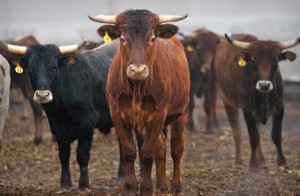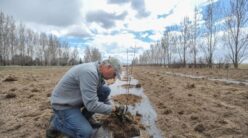By Keith Ridler/Associated Press
In this Nov. 11, 2004 file photo, livestock stand in a feedlot outside Caldwell, Idaho.
(AP Photo/Troy Maben, File)
BOISE, Idaho (AP) — An environmental group has settled a lawsuit against the U.S Forest Service with an agreement that suspends cattle grazing in a central Idaho area that includes part of the White Clouds Wilderness and has salmon-spawning habitat.
The agreement between Hailey, Idaho-based Western Watersheds Project and the Forest Service late last week removes cattle from portions of the East Fork of the Salmon River in the Sawtooth National Recreation Area this year and in 2018.
It also prevents their return until the area meets environmental standards set for the recovery of salmon, steelhead and bull trout, which are protected under the federal Endangered Species Act.
“We’re delighted we’ve gained at least two years of rest for these sensitive spawning streams from the impacts of livestock grazing,” Kristin Ruether, an attorney with Western Watersheds Project, said in a statement.
Kirk Flannigan, a Forest Service spokesman, didn’t return a call from The Associated Press on Friday.
The lawsuit filed in October contended the Forest Service broke environmental laws on the Upper and Lower East Fork allotments by issuing permits to livestock growers with a history of violating restrictions.
The lawsuit focused on the allotments for four ranchers at locations along the Salmon River’s upper east and lower east forks, asking a judge to reject the Forest Service’s recent approval of the grazing permits.
Rancher Syd Dowton said he used the upper allotment for grazing 145 to 160 cow-calf pairs, meaning one cow and its calf, each summer. He said that after the agreement that he’s had to cut down his herd size and find other areas to graze the remaining cattle this summer.
“I’m just not very optimistic that they’re going to get back there,” he said. “The restrictions are too high. It’s pretty discouraging. This year we’ve got probably the most grass I’ve ever seen in my life up there.”
The area could be prone to wildfire when the grass dries out, he said.
Congress approved the 142-square-mile White Clouds Wilderness in 2015. Dowton said he’s noticed an increase in visitors to the area since then.
“Gosh, yeah, there are just so many people that are up there anymore because it’s designated a wilderness,” he said. “They like to see what’s so special about it. And it is probably pretty special. It is very beautiful country.”
The wilderness designation includes allowing ranchers to retire grazing allotments with buyouts, something Dowton said he’s considering.
Western Watersheds Project said keeping domestic livestock out of the area for several years will prevent bank trampling and removal of streamside vegetation that causes shallower, warmer water that harms fish.
“We’re confident that this settlement will address the serious environmental problems that prompted the lawsuit in the first place,” Laurie Rule, an attorney with Advocates for the West, said in a statement.





